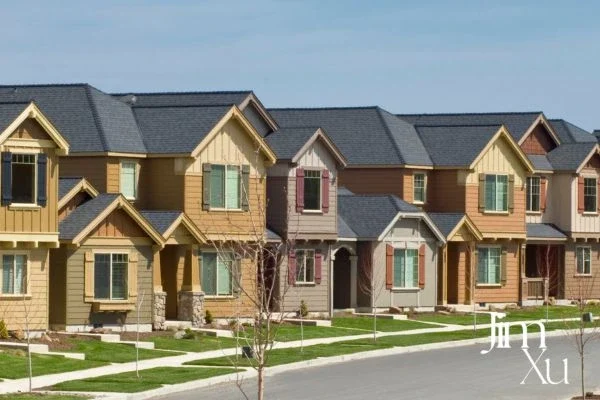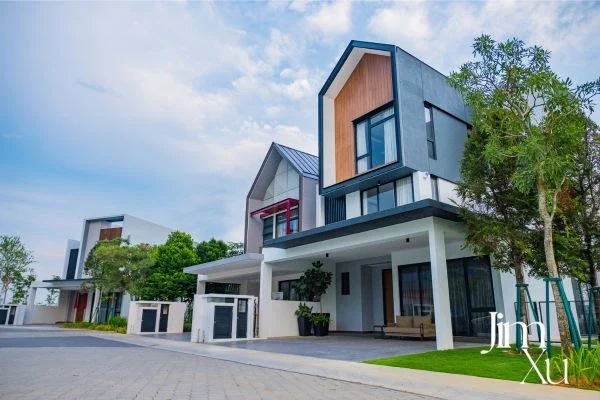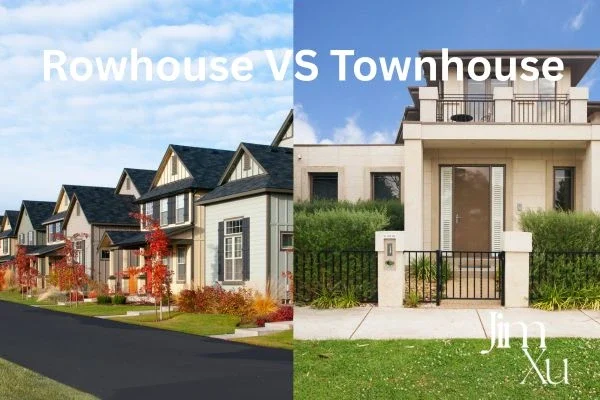When looking for a new home in Canada, you may come across two popular housing styles: rowhouses vs townhouses. These two types of homes often get confused due to their similar characteristics, but there are significant differences that can make a huge impact on your decision-making process. Whether you’re a first-time homebuyer or looking to make an investment in the Canadian real estate market, understanding the difference between townhouse and rowhouse is crucial. In this article Jim Xu will break down these two housing types to help you determine which one best suits your needs.
What is the Difference Between a Townhouse and a Rowhouse?

Both rowhouses and townhouses have shared walls with neighboring homes, but their design, location, and functionality can differ greatly. Before diving into the detailed explanation of each point, we have provided a summary table that outlines the key differences between townhouses and rowhouses. This table serves as a quick reference to give you an initial understanding of their distinctions. Following this, we offer a more comprehensive breakdown of each aspect, helping you make a well-informed decision for your home purchase.
| Feature | Rowhouse | Townhouse |
| Construction | Attached, load-bearing walls between units | Attached, non-load-bearing walls between units |
| Maintenance | Shared exterior and potentially some interior | Individual unit interior, shared exterior/common areas |
| Design | Compact, often historic styles | Often more spacious, more modern styles |
| Space | Potentially smaller | Potentially more spacious, with more yard or outdoor space |
| Price | Generally more affordable but can vary based on location and historical value | Often more expensive due to size and customization options |
| Location | Commonly found in older urban areas, city centers, or historic neighborhoods | More common in suburban areas but also found in urban developments |
1. Height and Size of Townhouse vs Rowhouse
One of the most notable differences between townhouses and rowhouses is their height. Rowhouses are typically uniform in height and can range from two to three floors, but some rowhouses, particularly in urban areas, can rise up to five stories. This uniformity is part of the rowhouse charm, often giving the street a cohesive appearance.
On the other hand, townhouses are usually two to three stories tall but offer more variety in terms of height. Townhouses tend to have more flexibility when it comes to their design, meaning that you may find homes of varying heights within the same development. If you’re looking for a little more individuality in your living space, townhouses might be the better option for you.
Also see: Townhouse in Vancouver
2. Location and Commonality of Townhouse vs Rowhouse
When deciding between rowhouse vs townhouse in Canada, location plays a significant role. Rowhouses are commonly found in older urban areas, especially in cities like Vancouver and Toronto. These homes were historically designed to accommodate growing populations in dense neighborhoods, particularly during the late 19th and early 20th centuries. Rowhouses are typically located in city centers or the outskirts of major metropolitan areas, where land was limited but the need for housing was growing.
In contrast, townhouses are more common in suburban areas. They can be found in both urban and suburban developments, offering more space and often providing a sense of community with shared amenities. The flexible design and layout of townhouses make them a popular choice for families who prefer a little more room and a quieter neighborhood compared to the hustle and bustle of city life.
3. Architectural Design and Aesthetics
Another key factor in choosing between a rowhouse or townhouse is their architectural style. Rowhouses have a more uniform appearance. Often, they are built in a row with identical facades, creating a visually cohesive street. These homes are typically built in a specific historical architectural style such as Victorian, Neo-Grec, or Gothic, and their design is intended to preserve the traditional aesthetic of the neighborhood.
Townhouses, however, provide more freedom in terms of design. While they may follow a similar theme, each townhouse can have different exterior features, including varying window placements, rooflines, and paint colors. This individualism allows homeowners to personalize their townhouse more than a rowhouse, especially if the property isn’t part of a strict homeowners association (HOA).
Read More: Difference Between Townhouse and Condo

4.Grouping and Layout of Rowhouse vs townhouse
Rowhouses are typically built in a straight line, often lining an entire street block. They are designed to form a cohesive row with a uniform layout. Due to their shared walls and uniformity, rowhouses are often restricted in terms of layout flexibility.
Townhouses, on the other hand, can be grouped together in clusters or form communities with shared spaces and private yards. They are usually located in suburban areas where there is more space, allowing for a more spread-out development. These properties often have more room for outdoor space or gardens, which can be an appealing feature for families or those looking for additional privacy.
5. Homeowners Association (HOA) and Maintenance Fees
One of the key differences between rowhouse and townhouse is their relationship with homeowners associations (HOA). Townhouses are more likely to be part of an HOA, particularly newer constructions. These associations help manage common areas, provide amenities, and enforce community rules. The fees for an HOA can range from a small monthly charge to upwards of $1,000 depending on the property’s amenities and location.
Rowhouses, on the other hand, are less likely to have an HOA, but this doesn’t mean they’re entirely without shared responsibilities. In some cases, rowhouses are part of a larger building with shared upkeep costs, but they generally don’t have the same level of structured community management that comes with townhouses.
6. Price and Affordability
Rowhouses tend to be more affordable in terms of purchase price compared to townhouses, mainly due to their location and the fact that they often don’t have the added cost of HOA fees. However, in highly urbanized areas, rowhouses might come at a premium price due to their historical value and prime location. Townhouses, especially those in suburban areas, can be more expensive because they offer more space, a larger yard, and greater customization options.
The price of both rowhouses and townhouses can vary greatly depending on location, size, and amenities.
It’s essential to take these factors into account when choosing the right home for your budget and lifestyle.
Read More: What is a townhouse

Also see: Townhomes for sale Burnaby
Which One Is Right for You? Rowhouse vs townhouse
When comparing rowhouse vs townhouse, it’s essential to consider what matters most to you. If you’re seeking a historical, urban lifestyle with a sense of community and easy access to city amenities, a rowhouse might be the perfect fit. However, if you’re looking for a more modern living space with flexibility, extra outdoor space, and a quieter neighborhood, a townhouse may be the ideal option.
In conclusion, both rowhouses and townhouses have their own set of benefits and drawbacks. By carefully considering factors like location, design, HOA fees, and the amount of space you need, you can make an informed decision that aligns with your lifestyle and budget. As always, I’m here to help you navigate the process of buying a townhouse or rowhouse in Canada. If you’re interested in finding the perfect property that suits your needs, feel free to reach out to me, Jim Xu, your trusted real estate advisor. Let’s find the home of your dreams together.






